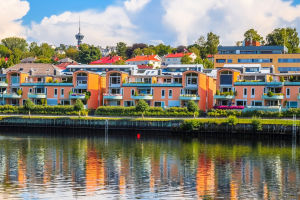Marine engineering involves constructing, modifying, and expanding projects to develop, utilize, protect, and restore marine resources. The majority of these projects are located on the seaward side of coastlines.
The main components of marine engineering include resource development technology and equipment, such as reclamation, sea dike projects, artificial islands, sea and undersea material storage facilities, cross-sea bridges, submarine tunnels, submarine pipelines, submarine electric (optical) cable projects, marine mineral resources exploration and development, offshore tidal power stations, wave power stations, and more.
Undersea tunnels are often associated with the thrill and length of the journey they provide. So, what are the world's famous undersea tunnels?
1. Anglo-French Cross-Harbour Tunnel
The Channel Tunnel between Britain and France is the world's longest undersea tunnel. It spans 50.5 kilometers from Folkestone in the UK to Calais in France, with a submerged length of 37.9 kilometers. According to the British railroad authorities, the tunnel can transport up to 18 million passengers and 8 million tons of freight per year.
2. Seikan Cross-Harbour Tunnel
The Seikan Cross-Harbour Tunnel in Japan connects Aomori in Honshu and Hakodate in Hokkaido, with a total length of 53.85 kilometers and a submerged length of 23.3 kilometers. It crosses the Tsugaru Strait between Honshu Island and Hokkaido, with a depth of 240 meters. It holds the Guinness World Record for the world's lowest railway line.
3. Tokyo Bay Water Tunnel
The Tokyo Bay Water Tunnel in Japan is 15.1 kilometers long and consists of three major sections: the shield tunnel on the Kawasaki side, the sea bridge on the Kisarazu side, and the approach section to the floating island on the Kawasaki side.
The Kawasaki artificial island was built in the middle of the 9.9-kilometer tunnel section to shorten the shield tunneling distance. The road tunnel was opened in 1997, greatly reducing traffic pressure in the Tokyo area and saving people traveling between Kawasaki and Kisarazu about 45 minutes per trip.
4. Lærdal Tunnel
The Lærdal Tunnel in Norway is the world's longest road tunnel. Its deepest point is 290 meters below sea level, with a horseshoe section of 4.6 meters x 8.5 meters.
Some areas have a wider section to accommodate additional emergency lanes and tunnel maintenance workspace. The 62m2 cross-sectional area of the tunnel was excavated simultaneously with the 12m to 30m long liaison tunnels, which were spaced 250 meters apart. The shotcrete lining and electromechanical installation work were carried out simultaneously.
5. Boryeong Cross-Harbour Tunnel
The Boryeong Cross-Harbour Tunnel in Korea is the country's longest undersea tunnel, with a total length of 6.927 kilometers in both directions. The tunnel is 55 meters below the sea floor and 80 meters above sea level, and it cost 485.3 billion won to construct. The drive from Daecheon Port in Boryeong-si to Taean-gun will be shortened by 80 minutes after the tunnel's opening, reducing travel time from 1.5 hours to less than 20 minutes.


